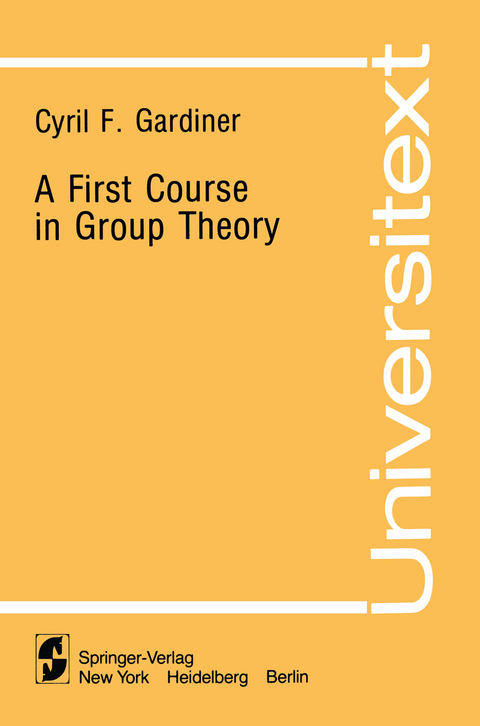
A First Course in Group Theory
Springer-Verlag New York Inc.
978-0-387-90545-7 (ISBN)
One of the difficulties in an introductory book is to communicate a sense of purpose. Only too easily to the beginner does the book become a sequence of definitions, concepts, and results which seem little more than curiousities leading nowhere in particular. In this book I have tried to overcome this problem by making my central aim the determination of all possible groups of orders 1 to 15, together with some study of their structure. By the time this aim is realised towards the end of the book, the reader should have acquired the basic ideas and methods of group theory. To make the book more useful to users of mathematics, in particular students of physics and chemistry, I have included some applications of permutation groups and a discussion of finite point groups. The latter are the simplest examples of groups of partic ular interest to scientists. They occur as symmetry groups of physical configurations such as molecules. Many ideas are discussed mainly in the exercises and the solutions at the end of the book. However, such ideas are used rarely in the body of the book. When they are, suitable references are given. Other exercises test and reinfol:'ce the text in the usual way. A final chapter gives some idea of the directions in which the interested reader may go after working through this book. References to help in this are listed after the outline solutions.
1 First Ideas.- 1.1 Introduction.- 1.2 The Definition of a Group.- 1.3 The General Associative Law.- 1.4 Further Examples of Groups.- 1.5 Aims.- Exercises 1.- 2 Multiplication Table, Generators, Relations, Isomorphism.- 2.1 Multiplication Table.- 2.2 Multiplication Table for the Dihedral Group D3.- 2.3 Order of an Element.- 2.4 The Symmetric Group Sn.- 2.5 Isomorphism n.- 2.6 Generators and Relations.- 2.7 All Possible Groups of Orders 1, 2, 3, 4.- 2.8 Some Results on Orders of Elements.- Exercises 2.- 3 Subgroups, Lagrange’s Theorem, Cyclic Groups.- 3.1 Cosets and Lagrange’s Theorem.- 3.2 Some Results on Subgroups.- 3.3 Generators.- 3.4 Products of Subsets of Groups.- 3.5 Cyclic Groups.- 3.6 Subgroups of S3.- Exercises 3.- 4 Factor Groups, Permutation Representations, Finite Point Groups.- 4.1 Normal Subgroups.- 4.2 Simplicity.- 4.3 Conjugacy.- 4.4 Conjugacy Classes.- 4.5 Homomorphisms.- 4.6 Permutation Representation of a Group.- 4.7 Subgroups of Factor Groups.- 4.8 Factor Groups of Factor Groups.- 4.9 Groups of Order p2, p prime.- 4.10 Symmetry and the Orthogonal Group.- 4.11 Classification of the Finite Rotation Groups.- 4.12 Examples of Finite Rotation Groups.- 4.13 Classification of Finite Point Groups of the Second Kind.- 4.14 Examples of Some of the Finite Point Groups of the Second Kind.- Exercises 4.- 5 Finitely Generated Abelian Groups.- 5.1 Introduction.- 5.2 Direct Sum.- 5.3 Free Abelian Groups.- 5.4 Structure Theorems for Finitely Generated Abelian Groups.- 5.5 Uniqueness.- 5.6 Possible Groups of Order p2.- Exercises 5.- 6 The Sylow Theorems.- 6.1 Introduction.- 6,2 Double Cosets.- 6.3 The Sylow Theorems.- 6.4 Applications of the Sylow Theorems.- Exercises 6.- 7 Groups of Orders 1 To 15.- 7.1 Introduction.- 7.2 Groups of Order 6.- 7.3 Groups of Order7.- 7.4 Groups of Order 8.- 7.5 Groups of Order 9.- 7.6 Groups of Order 10.- 7.7 Groups of Order 11.- 7.8 Groups of Order 12.- 7.9 Groups of Order 13.- 7.10 Groups of Order 14.- 7.11 Groups of Order 15.- 7.12 Summary.- Exercises 7.- 8 Epilogue.- 8.1 Introduction.- 8.2 Construction of Finite Groups.- 8.3 Solvable and Nilpotent Groups.- 8.4 The Isomorphism Theorems.- 8.5 The Schreier-Jordan-Hölder Theorem.- 8.6 Some Basic Results on Solvable Groups.- Exercises 8.- Miscellaneous Exercises.- Outline Solutions to the Exercises.- Exercises 1.- Exercises 2.- Exercises 3.- Exercises 4.- Exercises 5.- Exercises 6.- Exercises 7.- Exercises 8.- Miscellaneous Exercises.- Further Reading and References.- Intermèdiate.- Advanced.- Sources of Further Problems.- References.- Further Reading and References for Scientists.- General Reference.
| Erscheint lt. Verlag | 19.1.1981 |
|---|---|
| Reihe/Serie | Universitext |
| Zusatzinfo | X, 228 p. |
| Verlagsort | New York, NY |
| Sprache | englisch |
| Maße | 155 x 235 mm |
| Themenwelt | Mathematik / Informatik ► Mathematik ► Algebra |
| ISBN-10 | 0-387-90545-6 / 0387905456 |
| ISBN-13 | 978-0-387-90545-7 / 9780387905457 |
| Zustand | Neuware |
| Haben Sie eine Frage zum Produkt? |
aus dem Bereich


